|
Tradewind Air Lease (TAL)
operates a variety of passenger and cargo aircraft and is one of the largest
and most efficient wet lease airlines in the World. AIr Lease has its
headquarters in the Caribbean and bases worldwide operating both short
and long term contracts.
(See
leasing definitions)
FLIGHT CAPACITY FOR AIRLINES
AND TOUR OPERATORS:
The company has a highly
trained core of experienced individuals, who specialise in setting up
operations anywhere in the world at a moment's notice. All members of
staff are capable of working in any environment and national culture and
can adopt procedures and techniques to the customer's requirement, while
maintaining safe and efficient standards of operations.
A large market share, strong
brand name, impressive customer base and superior know-how are just a
few of the core assets of AIr Lease. AIr Lease's primary goal is to provide
reliable, fast and comprehensive service to other airlines and tour operators
in need of additional capacity. The company has an excellent reputation
as a world-class provider of reliable high quality service.
WORLDWIDE AIRPORT BASES:
AIr Lease has operating bases worldwide and is able to open mobile offices
with short notice.
FLEET OF APPROXIMATELY 50 AIRCRAFT, MAINTAINED AND OPERATED TO HIGHEST
STANDARDS:
AIr Lease's fleet is composed of many aircraft types.
The aircraft are leased
for various projects, with any interior layout. The aircraft are modified
to best meet our customers' individual needs while maintaining safe and
efficient operations.
Tradewind AIr Lease is currently
operating on behalf of the following operators however don't be restricted
by this you can effectively operate anywhere
and for any airline.
This
includes aircraft painted in full leasee livery (available from other
sites) :
RECORDING
TAL FLIGHTS USING THE OFR (Online
Flight Reporter):
1. Log
in as normal
2. Select
'Individual Report'
3. Enter
'0000' then click on 'Report'
4. In
'Used Aircraft' section select one of the generic types or 'Other
Aircraft', add comments and press 'Report'
|
|

IATA Code: B3
ICAO Code: BLV
Known As: Bellview Airlines
Full Name: Beliview Airlines Ltd.
Country: Nigeria
Hubs: Lagos
Callsign: Bellview
Web Site: www.flybellviewair.com
|
Lagos - Bombay
Flt No:B3 270
Daily 20:00 10:30
+ 1 hour
Bombay - Lagos
Flt No B3
271
Daily 01:50hours
07:00
+ 1 hours
Aircraft: B747-200
- Type: Pax
|
|

IATA Code: BG
ICAO Code: BBC
Known As: Biman Bangladesh Airlines
Full Name: Biman Bangladesh Airlines
Country: Bangladesh
Hubs: Dhaka
Callsign: Bangladesh
Web Site: www.bangladeshonline.com/biman/
|
Dhaka - Chittagong
Flt No: BG 617
Daily 16:45 17:20
Chittagong - Dhaka
Flt No: BG618
DAILY 17:50 18:25
Aircraft: DC-10-30ER
- Type: Pax
|
|

IATA Code: BF
ICAO Code: BBD
Known As: Bluebird Cargo
Full Name: Bluebird Cargo Ltd.
Country: Iceland
Hubs: Keflavik
Callsign: Blue Cargo
Web Site: www.bluebirdcargo.com
|
Luxemburg - Keflavik
Flt No: BBD 6812
Daily 08:00 11:30
Keflavik - Luxemburg
Flt No: BBD 6813
Daily 12:30 16:00
Aircraft: B737-300SF
- Type: Cargo
|
|

IATA Code: 5T
ICAO Code: ANX
Known As: Canadian North
Full Name: Air Norterra, Inc dba. Canadian North
Country: Canada
Hubs: Yellowknife
Callsign: Empress
Web Site: www.canadiannorth.com
|
Edmonton International
- Yellowknife
Flt No: 5T 444
Daily 08:00 09:41
Flt No: 5T 422
Daily 19:30 21:09
Yellowknife -
Edmonton International
Flt No: 5T 423 Daily 07:30 09:09
Flt No: 5T 445
Daily 16:45 18:20
Aircraft: Fokker
100 - Type: Pax
|
|

IATA Code: WD
ICAO Code: DAZ
Known As: Das Air Cargo
Full Name: Das Air Cargo Ltd.
Country: Kenya
Hubs: Lagos
Callsign: Dasair
Web Site: www.dasair.com
|
Dar es Salaam,
Tanzania- Amsterdam, Netherlands
Flt No: WD 110
Ad hoc charters
Mondays, Wednesdays and Fridays
Amsterdam, Netherlands
- Dar
es Salaam, Tanzania
Flt No: WD 111
Ad hoc charters
Tuesdays, Thursdays and Saturdays
Aircraft: DC-10-30F/B747-200F
- Type: Cargo
|
|
 
IATA Code: E3
ICAO Code: DMO
Known As: Domodedovo Airlines
Full Name: Domodedovo Airlines Joint Stock Aircompany
Country: Russian Federation
Hubs: Moscow, DME
Callsign: Domodedovo
Web Site: www.akdal.ru
|
Domodedovo -
Lisbon
Flt No: E3 401
Daily 16:40 11:40
Lisbon - Domodedovo
Flt No: E3 402
Daily 20:40 04:45
Aircraft: B767-300
- Type: Pax
|
|

IATA Code: ZB
ICAO Code: MON
Known As: Monarch Airlines
Full Name: Monarch Airlines Ltd.
Country: United Kingdom
Hubs: London, LTN
Callsign: Monarch
Web Site: www.flymonarch.com
|
Manchester, UK
- Barcelona, Spain
Flt No: ZB 601
Daily 08:40 11:25
Barcelona, Spain
- Manchester, UK
Flt No: ZB 602
Daily 12:10 13:40
Aircraft: B717-200
- Type: Pax
|
|

IATA Code: PH
ICAO Code: PAO
Known As: Polynesian Airlines
Full Name: Polynesian Airlines Ltd.
Country: Samoa
Hubs: Apia
Callsign: Polynesian
Web Site: www.polynesianairlines.com
|
Nadi, Fiji Islands
- Apia, Samoa
Flt No: PH 566
Daily 01:45 03:35
Apia, Samoa -
Nadi, Fiji Islands
Flt No: PH 565
Daily 05:35 06:35
Aircraft: Fokker
F-100 - Type: Pax
|
|

IATA Code: DT
ICAO Code: DTA
Known As: TAAG Air Angola
Full Name: Linhas Aereas de Angola
Country: Angola
Hubs: Luanda
Callsign: DTA
Web Site:
|
Luanda, Angola
- Johannesburg, S Africa
Flt No: DT 577
Daily 09:45 13:20
Johannesburg,
S Africa - Luanda, Angola
Flt No: DT 578
Daily 15:00 17:20
Aircraft: B747-200
- Type: Pax
|
info & logos
courtesy of aerosite.net
_____________________________________________________________________________________________
Tradewind AIr Lease
aircraft
Callsign ~ Dependant on
contracting airline
For short term leases aircraft
operate in TAL livery, for medium term leases they may have contracting
airline stickers applied, for long contracts full livery might be applied.
|
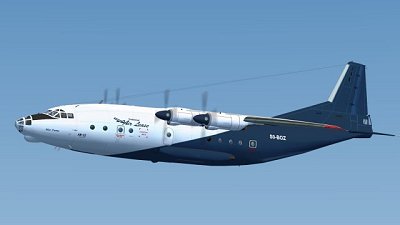
S9-BOZ
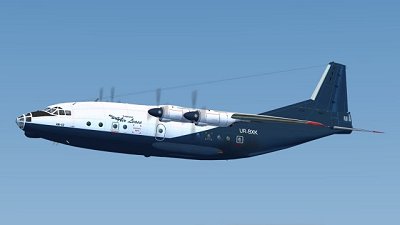
UR-BXK
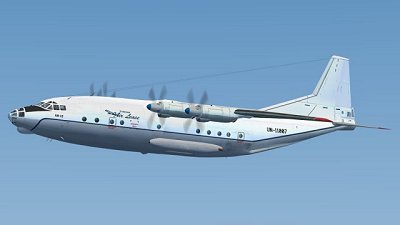
UN-11007
FS9 FSX
|
|
Antonov
An-12B ~ Vladimir Zhyhulskiy
The
An-12 (NATO reporting name "Cub") was developed
to fulfil a Soviet air force requirement for a turboprop
freighter. Based on the twin turboprop An-8 which was developed
for Aeroflot service, the four engine An-12 was developed
in parallel with the commercial passenger An-10.
The prototype
An-12 flew in 1958, powered by Kuznetsov NK-4 turboprops,
and was essentially a militarised An-10 with a rear loading
cargo ramp. Approximately 100 An-10s were built, the type
seeing service between 1959 and 1973.
Series production
of the An-12 in a number of mainly military variants continued
until 1973, from which time it was replaced in Soviet service
by the Ilyushin Il-76 (described elsewhere). The An-12BP
is the basic military transport version of the Cub. Other
military versions are in use as Elint and ECM platforms.
The defensive
rear gunner's turret is faired over on civil An-12s. Operators
have included Aeroflot, Cubana, LOT Polish Airlines and
Bulair for civil and quasi military work.
China's Xian
began redesign work of the An-12 in 1969, but after the
first prototype the program was transferred to Shaanxi.
A number of Chinese versions were developed, including the
civil variants Y-8B and Y-8C, the latter developed with
cooperation from Lockheed, similar Y-8F-200, Y-8F livestock
carrier and Y-8H aerial survey model.
|
|
|
Other Suggested Files:
|
Repaint by JF
|
|
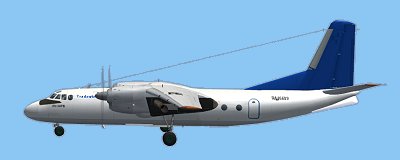
RA
46609
FS9
ONLY
Texture
ONLY
|
Antonov
An-24RV ~ SamDim Design
The
An-24 is the original aircraft in a prolific and highly
successful family of twin turboprop civil and military
transports. The
An-24 first flew in April 1960 with first production versions
entering Aeroflot service in September 1963. Aeroflot
was the largest An-24 operator, with others going to Soviet
client nations.
Subsequent
production versions of the An-24 were the An-24B and the
An-24T freighter. A small turbojet in the right engine
nacelle to boost takeoff performance resulted in the An-24RT
and An-24RV. The An-24P firebomber was also developed
before Ukrainian production ceased in 1978.
The
An-24 was also developed into the An-26 "Curl"
military tactical transport with more powerful engines
and redesigned tail, which itself evolved into the An-32
with enhancements for better hot and high performance.
Over 550 An-26s are in civil service.
The
An-30 development has been produced in limited numbers
and is used largely for aerial survey and cartography
work. This version is identifiable by its extensive nose
glazing.
The
An-32 first flew in 1976 and features much more powerful
3760kW (5042ehp) Progress engines for improved hot and
high performance. The An-32 features above wing mounted
engines to give the larger diameter props adequate ground
clearance.
China's
Xian Aircraft Manufacturing Company is now the sole production
source for the An-24 as the Y-7. The Y-7-100 incorporates
a number of modifications including a revised passenger
interior and flightdeck, and wingtip winglets. It was
developed with the technical assistance of HAECO in Hong
Kong during the 1980s.
|
|
|
Other Essential Files:
You need to have
already installed the v2.02 Base Package from: Avsim + patch
|
Repaint by JF
Textures only
|
|
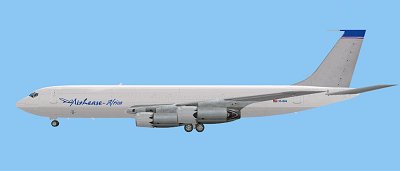
AirLease
Africa/Afrikaanse 3C- GIG
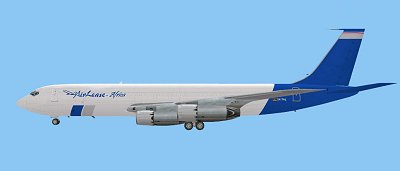
AirLease
Africa/Afrikaanse 5X-TAL
FS9
ONLY
Textures
ONLY
|
Boeing
707-320C (Cargo) ~ HJG
The
707's jet speed, long range, high seating capacity and
operating economics revolutionised airliner travel when
it was introduced into service in 1958. The 707 also laid
the foundations for Boeing's dominance of the jet airliner
market.
Recognising
the jet engine's potential for commercial aviation, Boeing
(at great financial risk) decided to develop a jet powered
transport that could fulfil military tanker transport
roles but be easily adapted to become an airliner. The
resulting prototype, known as the 367 Dash 80, flew for
the first time on July 16 1954. Impressed, the US Air
Force ordered a larger version, with a wider fuselage
(12 ft, vs 11 ft for the Dash 80) into production as the
KC-135 tanker/transport (more than 800 were built). At
first, Boeing wanted to sell the same size aircraft to
the airlines, but the airlines insisted on an even larger
airplane, which Douglas promised to build (this became
the DC-8). Boeing finally relented, designing the 707
as a longer aircraft with a slightly wider fuselage (12
ft 4 in).
The
first production 707 (a 707-120 for Pan Am) flew on December
20 1957, and entered service later the following year.
Developments of the 707-120 include the similar 707-220,
the shorter 138 for Qantas, and the stretched 707-320,
which flew in July 1959. The 707-120 and 320 were later
reengined with JT3D turbofans (in place of the original
JT3 and JT4 turbojets) to become the 707-120B, and the
707-320B respectively. The 707-320C was a convertible
model, the 707-420 was powered by RollsRoyce Conways,
while the proposed CFM-56 powered 707-700 upgrade was
flight tested in the late 1970s but never entered production.
Most
civil 707s in service today have been converted to freighters
(as is the case with the TAL aircraft - acquired specifically
for use in the African Market), while a number are used
as corporate transports.
Many
air forces have bought 707s, new or converted second-hand
aircraft, for general transport, aerial refuelling, and
electronic warfare. The E-3 Sentry is a dedicated airborne
warning and control system (AWACS) platform with a large
rotodome above the fuselage. The E-6 Mercury performs
the TACAMO (Take Charge and Move Out) role with the US
Navy, maintaining communication with the ballistic missile
submarines. The E-8 J-Stars (Joint Surveillance Target
Attack Radar System) performs the battlefield control
role. Other military 707s received the designations C-137,
or C-18, but many others have no special military designation
|
|
|
Other Essential Files:
You need to have
already installed the HJG B707-320C Base Pack available HERE
Effects, Panel and Sound also from the HJG site.
|
Repaint by JF
|
|
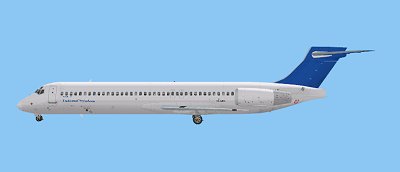
EI-
GAG
|
Boeing
717-200 ~ Jet City
The
100 seat 717 is the latest development of the popular
DC-9/MD-80/MD-90 family and the only Douglas airliner
which Boeing (which merged with McDonnell Douglas in 1997)
plans to retain in its product line-up. It is designed
for high cycle, short range regional airline operations.
McDonnell Douglas first announced the MD-95 at the Paris
Airshow in June 1991. At the time MDC anticipated a formal
program launch by late 1991 and a first flight in July
1994. As it happened program launch was not until October
1995 when US airline ValuJet (now AirTran Airlines) ordered
50 and optioned 50.
In January 1998 Boeing (following the August 1997 Boeing/McDonnell
Douglas merger) relaunched the aircraft as the 717-200
(the second use of the Boeing designation "717",
as this was previously allocated to the military C-135/KC-135
family). First flight took place on September 2 1998,
followed by a second development 717 on October 26. Certification
was awarded on September 1 1999
|
|
|
Other Suggested Files:
|
Repaint by JF
Includes 2D panel
|
|
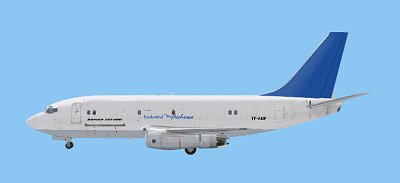
TF-ABF
Cargo Hush-Kit
(Also
includes N732TA 'Yukon' Pax and N732TC 'Yukon Trader' Cargo Hush-Kit)
HERE
Textures
ONLY
FS9
|
Boeing
737-200 v2 ~ Tinmouse II
The
737-100 and 200 are the first generation production models
of the world's most successful jet airliner family, Boeing's
737 twinjet.
The 737 was conceived as a short range small capacity
airliner to round out the Boeing jet airliner family beneath
the 727, 720 and 707. Announced in February 1965, the
737 was originally envisioned as a 60 to 85 seater, although
following consultation with launch customer Lufthansa,
a 100 seat design was settled upon. Design features included
two underwing mounted turbofans and 60% structural and
systems commonality with the 727, including the same fuselage
cross section (making it wider than the competing five
abreast DC-9 and BAC-111).
The 737-100 made its first flight on April 9 1967 and
entered service in February 1968 with Lufthansa, while
the last of 30 built was delivered to Malaysia-Singapore
Airlines in October 1969.
By this time however the larger capacity 1.93m (6ft 4in)
stretched 737-200 was in service after it had made its
first flight on August 8 1967. First delivery, to United,
was that December.
Developments of the -200 include the -200C convertible
and quick change -200QC, while an unprepared airfield
kit was also offered. The definitive Advanced 737-200
appeared in 1971, featuring minor aerodynamic refinements
and other improvements.
Sales of the 737-200 far exceeded that of the shorter
-100 and the 737-200 remained in production until 1988,
by which time it had been superseded by the improved 737-300,
after 1114 had been built. Many have been fitted with
Stage 3 engine hushkits, and a number of passenger aircraft
have been converted with cargo doors.
The USAF ordered 19 as navigation trainers, and some were
later converted to standard transport aircraft as CT-43A.
A few other air forces received 737-200s to serve in general
transport, surveillance or VIP transport tasks.
|
|
|
Other ESSENTIAL Files:
FSX Base Pack v 1.30
FS9 Base Pack v1.30
Shared updates: v1.31 v1.32 v1.40 wide screen
Check the Avsim Tinmouse
forum for updates
|
Repaint by JF
Must read the docs
!
|
|
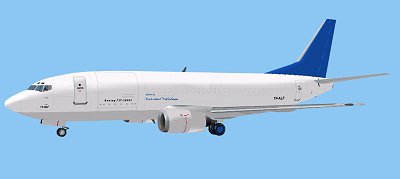
TF-
ALF
FS9
ONLY
TEXTURES
ONLY - You need to have
Tradewind
Logistics PJ-SPA
'Fleetwing'
already
installed
|
Boeing
737-300SF ~ FFX
The
737-300 is the first of the three member second generation
CFM56 powered 737 family, which also comprises the stretched
737-400 and shortened 737-500. The success of the second
generation Boeing 737 family pushed sales of the mark
to over 3000, a record for a commercial jetliner.
Despite
the all new engines and the 2.64m (104in) fuselage stretch,
the 737-300 retains 80% airframe spares commonality and
shares the same ground handling equipment with the 737-200.
A number of aerodynamic improvements were incorporated
to further improve efficiency including modified leading
edge slats and a new dorsal fin extending from the tail.
Another feature was the flattened, oval shaped engine
nacelles, while the nosewheel leg was extended to increase
ground clearance for the new engines. Other internal changes
include materials and systems improvements first developed
for the 757 and 767 programs, including an early generation
EFIS flightdeck (with four colour CRT screens).
The
737-300SF passenger to freighter conversion is by Israel
Aircraft Industries (IAI), Bedek Aviation Group.
|
|
|
Other Suggested Files:
Updated aircraft.cfg
file (courtesy of Karl Hajek)
|
Repaint by JF
INCLUDES PAUL SCARRATT'S
CLASSIC PANEL
|
|
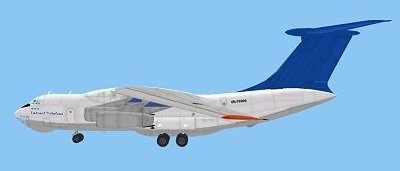
UN
76009
FS9

|
IL-76TD
~ Shevtsev
& Varnavskiy Sergey
Designed
The Ilyushin Il-76 (which has the NATO reporting name
of `Candid') was developed as a replacement for the turboprop
powered Antonov An-12, mainly for military use.
Development
under the design leadership of G V Novozhilov in the late
1960s resulted in the type's first flight on March 25
1971. Series production commenced in 1975 and the first
examples entered Aeroflot service that year. In the now
classic military freighter configuration, the Il-76 features
a high mounted wing passing above the fuselage, four engines,
Ttail, rear loading ramp and freight doors.
The
Il-76 was also designed with short field performance in
mind, operating from austere strips. To this end the Il-76
features wide span triple slotted trailing edge flaps,
upper surface spoilers and near full span leading edge
slats for short field performance, while the aircraft
rides on a total of 20 low pressure tyres, the front nose
unit featuring four wheels, the main wheel bogies having
two rows of four tyres each. Freight handling is largely
mechanised, requiring only two freight handlers which
can be carried as part of the standard crew complement
of seven.
Civil
versions developed from the basic Il-76 include the Il-76T
with additional fuel; the Il-76TD with increased takeoff
and payload weights and D30KP2s which retain their power
output to higher altitudes; and the Il-76MP firefighter.
The
stretched PS90 powered Il-76MF, which first flew on August
1 1995, will be built in Tashkent. Stage 3 compliant,
it is primarily intended for the Russian air force. Ilyushin
also plans to build a CFM56 powered version of this aircraft.
|
|
|
Other Suggested Files:
|
Repaint by JF
PANEL ~
SOUNDS ~ included
|
|
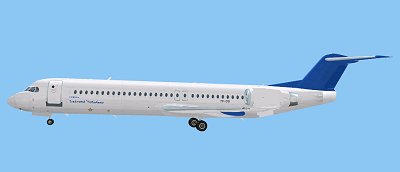
TF-
IOO
|
Fokker
F-100 Tay 650 ~ Project Fokker
Fokker's
largest aircraft, the Fokker 100 is a 100 seat jet airliner
based on the F-28 Fellowship, but stretched and thoroughly
modernised.
Fokker announced it was developing the Fokker 100 simultaneously
with the Fokker 50 turboprop in November 1983. The Fokker
100 is based on the basic F-28 airframe, with the most
important and obvious change being the stretched fuselage,
increasing maximum seating to 122, compared with 85 in
the F-28-4000 (on which the 100 is based). Other changes
include more economical RollsRoyce Tay turbofans (which,
unlike the F-28's Speys, conform to Stage 3 noise limits),
revised wing design with greater span and aerodynamic
efficiency (Fokker claimed it to be 30% more efficient
than the F-28's), a modern EFIS glass flightdeck, redesigned
cabin interior plus other systems and numerous equipment
changes.
The
Fokker 100 was offered in a number of versions including
higher gross weight options of the standard airliner,
the Fokker 100QC Quick change airliner or freighter with
a large forward freight door and the Fokker Executive
Jet 100 corporate shuttle or VIP transport, fitted with
luxury interiors to customer requirements. It also forms
the basis for the shorter Fokker 70
|
|
|
Other Essential Files:
You need to have
already installed the Base Package from:
Base Pack v2.0 Panel Update Add-on v3
|
Repaint by JF
Textures only
|
|
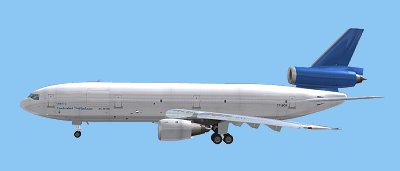
TF-
BOX (30F -Cargo)
Includes
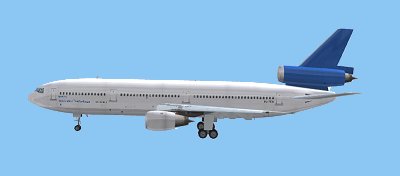
PJ-TEN
(30ER - Pax)
FS9
& FS2002 with mods - see docs
|
MD
DC-10-30ER & F ~ SGA
Designed
in response to the same American Airlines requirement
as the Lockheed TriStar, the DC-10, despite a sometimes
troubled past, was the more successful of the two widebody
trijets.
Although originally conceived as a twinjet, the DC-10
gained a third engine at the base of its vertical tail
to meet an American Airlines requirement that the aircraft
be capable of operating from existing runways. The DC-10
subsequently was launched in February 1968 with orders
from American and United. First flight took place on August
29 1970
Designed
in response to the same American Airlines requirement
as the Lockheed TriStar, the DC-10, despite a sometimes
troubled past, was the more successful of the two widebody
trijets.
Although originally conceived as a twinjet, the DC-10
gained a third engine at the base of its vertical tail
to meet an American Airlines requirement that the aircraft
be capable of operating from existing runways. The DC-10
subsequently was launched in February 1968 with orders
from American and United. First flight took place on August
29 1970
|
|
|
Other Suggested Files:
The panel is configured
for use with the Delco Carousel IV-A Inertial Navigation System
Gauge CIVA140.zip
required available
from flightsim.com and other locations
Optional but recommended:
aircraft.cfg
update
based on real world AOM data by Karl Hajek
|
Repaint by JF
PANEL ~ with photoreal
bmps included
The panel requires some
mods for FS2002 compatibility - see docs
|
|

